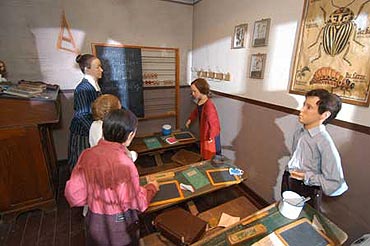Schrift: größer/kleiner
Inhaltsverzeichnis
Sie sind hier: WirRheinländer > english version > The Exhibition > Scenes > School – 1947
School – 1947

Like most buildings, many schools had been damaged extensively by the rain of bombs unleashed by Allied air-raids. Images of the time show destroyed windows, missing roofs and gaps in walls. Schoolchildren had to huddle together in the few remaining intact classrooms. It was not uncommon for up to sixty pupils to be in one class. There was hardly any paper, so writing was done in pencil or on slate. The first winter after the war, 1945-46, was bitterly cold. In order to heat the schools, pupils had to bring fuel with them. Most of them managed to find scrap wood or something on the way, but one of the biggest problem for post-war children was hunger. Ration-cards for food were distributed, but not everything was always available. One remedy was school lunch. From March 1946 school lunches were provided in the British occupied zone, taken from army supplies. Additional aid came in the form of CARE parcels from the USA and of support given by the Quakers in Britain.
A witness reports:
"(I) was so happy and overjoyed that the children of our school should have school lunches, especially at the start of the cold season.. Of course everyone was cheering. Every child brought some kind of cutlery and the parents willingly paid for the food. And how happy it made me to see the children feasting, their eyes shining, to hear that they were well pleased. For the food is not only nutritious, warming and filling, but is also well-prepared and tastes good. For many children the school lunch is the highlight of the schoolday."
(Zeitbrüche - Lebensbrüche. Frauen erinnern sich an das Jahr 1945. Erfurt 1995, S.100.)


